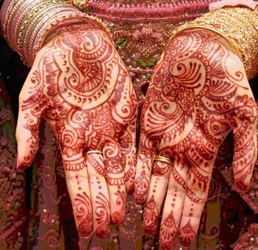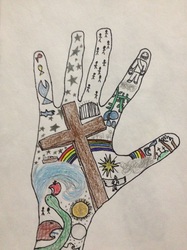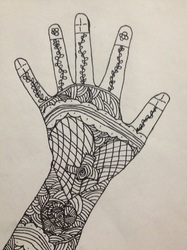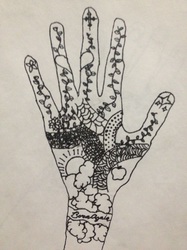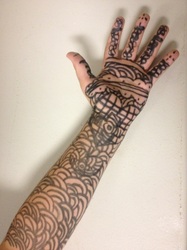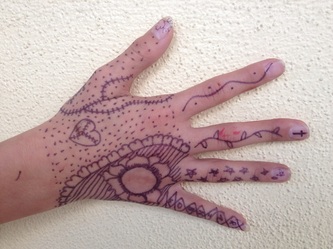Telling Your Story Through Art
Theme: Art, Social Studies
Grade Level: 4th—8th grade
Time Frame: 7 to 8 classes
Scripture Integration
Ephesians 2:10, “For we are his workmanship, created in Christ Jesus for good works, which God prepared beforehand, that we should walk in them.”
Unit Overview
This unit is to assist the student in developing his or her story and then sharing it through art. The lesson addresses identity as defined by society in general, and then adds the dimension of Christianity. Students will define and establish their idea of what the word identity means and use adjectives to describe themselves. Students will listen to the story of Chè Orman Gardner. After hearing the story of Chè, students will discuss as a class how she used her identity/her story to encourage others. Then they will divide into groups of two or three to discuss their own stories. They will be asked to focus on the things that make up their story and their unique identity. Then they will discuss which aspects about themselves the feel would be most important to share with the women in South Asia. Feedback amongst the students will be highly encouraged. Next, each student will write the key points of their story and develop symbols that represent each key point.
Once their stories are developed and symbols sketched, the students will trace their hand on a piece of white construction paper. They will create a design within the outline of their hand, using their key point images. Positioning the symbols is very important since it determines the progression and way in which a story is told.
Students will discuss their designs within their small group and critique each other’s work. Once they are satisfied with their design, they will use washable markers to draw their designs on each other’s hands. As they move from one symbol to the next, they will share the key points of their story.
Lesson Objectives
Key Terms
Identity
South Asia
Culture
Henna
Symbol
Lesson 1: Chè’s Story
Overview
Students will define the word identity and discuss how they view their own identity, describing themselves using adjectives. Students will listen to the story of Chè Orman Gardner. After hearing the story, students will discuss how Chè used her story to encourage others. The students will then divide into groups of two or three to discuss their own stories. They will talk about what they would share about themselves with the women in South Asia and give feedback to each other.
Supplies
Henna tattoo picture from The Henna Gospel (2011)
Internet connection to YouTube for video
Essential Questions
Introduction
The students will be asked to define the word identity. After the class establishes their idea of what identity means, students will be asked to use adjectives to describe themselves.
Process
Lesson 2: Developing The Story
Overview
Each student will write the key points of their story and create symbols that represent each key point. After their stories are developed and symbols sketched, the students will trace their hand on a piece of white construction paper. They will create a design within the outline of their hand, using their key point symbols. Positioning of the symbols is very important since it determines the progression and way in which a story is told.
Supplies
Pencils
Erasers
Scrap paper
White construction paper
Essential Questions
Introduction
The instructor will give a short review of Chè’s story.
Process
Lesson 3: Sharing The Story
Overview
Once the students are satisfied with their design, they will use washable markers to draw their designs on each other’s hands. As they move from one symbol to the next, they will share the key points of their story.
Supplies
Washable markers
Essential Questions
Introduction
The instructor will have the students divide into their groups.
Process
Lesson 4: Making The Plaster-Cast
Note: Get parent permission for casting the student’s hand. Some student may have a slight allergy to the plaster.
Overview
Students will plaster-cast their hand. They will paint it with their created story design.
Supplies
Plaster Gauze
Vaseline Petroleum Jelly
Waxed paper
Trays/cookie sheets/heavy cardboard
Plastic disposable dishes (cool whip size)
Old t-shirts
White acrylic or latex paint (house paint is cheaper than acrylic)
Permanent Markers
Essential Questions
Process
Assessment
Students will be evaluated on their planning, process, and the finished quality of their personal image.
Grade Level: 4th—8th grade
Time Frame: 7 to 8 classes
Scripture Integration
Ephesians 2:10, “For we are his workmanship, created in Christ Jesus for good works, which God prepared beforehand, that we should walk in them.”
Unit Overview
This unit is to assist the student in developing his or her story and then sharing it through art. The lesson addresses identity as defined by society in general, and then adds the dimension of Christianity. Students will define and establish their idea of what the word identity means and use adjectives to describe themselves. Students will listen to the story of Chè Orman Gardner. After hearing the story of Chè, students will discuss as a class how she used her identity/her story to encourage others. Then they will divide into groups of two or three to discuss their own stories. They will be asked to focus on the things that make up their story and their unique identity. Then they will discuss which aspects about themselves the feel would be most important to share with the women in South Asia. Feedback amongst the students will be highly encouraged. Next, each student will write the key points of their story and develop symbols that represent each key point.
Once their stories are developed and symbols sketched, the students will trace their hand on a piece of white construction paper. They will create a design within the outline of their hand, using their key point images. Positioning the symbols is very important since it determines the progression and way in which a story is told.
Students will discuss their designs within their small group and critique each other’s work. Once they are satisfied with their design, they will use washable markers to draw their designs on each other’s hands. As they move from one symbol to the next, they will share the key points of their story.
Lesson Objectives
- The students will gain insight into their own identity.
- The students will grow in their understanding of how to share their story with others..
- The students will explore the role of art in self-expression.
- The students will explore the use of symbolism.
- The students will mature in their knowledge of the diversity of cultures, and the treatment of women in other countries.
- The students will learn art is a universal language.
- The students will learn sharing their stories can impact the life of someone else.
Key Terms
Identity
South Asia
Culture
Henna
Symbol
Lesson 1: Chè’s Story
Overview
Students will define the word identity and discuss how they view their own identity, describing themselves using adjectives. Students will listen to the story of Chè Orman Gardner. After hearing the story, students will discuss how Chè used her story to encourage others. The students will then divide into groups of two or three to discuss their own stories. They will talk about what they would share about themselves with the women in South Asia and give feedback to each other.
Supplies
Henna tattoo picture from The Henna Gospel (2011)
Internet connection to YouTube for video
Essential Questions
- How do you define identity?
- What adjectives would you use to describe yourself?
- What aspects about yourself do you feel would be most important to share with the women in South Asia?
Introduction
The students will be asked to define the word identity. After the class establishes their idea of what identity means, students will be asked to use adjectives to describe themselves.
Process
- The Instructor will share Chè’s story. The artist/missionary/educator Chè Orman Gardner is introduced. This is Chè’s story (C. O. Gardner, personal communication, 2013). Chè is the daughter of a pastor and was raised in a Christian family. At an early age she committed her life to following Christ. After high school, she attended Liberty University in Lynchburg, Virginia. Upon graduating, Chè joined a missionary team and moved to South Asia. There her life was much changed due to cultural differences. At times, she was in danger because she was Christian and because she was a woman. Throughout South Asia women are treated differently, more subservient than in the United States. Furthermore, they have no rights, and for the most part are treated as slaves. Chè experienced first hand the vast differences between cultures. She witnessed how long-held beliefs and social arrangements can determine one’s identity and opportunities.
As a Christian, Chè believed that each of us is created as a treasure, possessing different strengths, talents, and abilities. Her heart ached for the women of South Asia and she wanted to share her story with them. She wanted them to understand that they were important, not worthless like they were being told and treated. Her identity was founded in strength and love for all God’s unique creations and she needed to share her story with them. Therefore, Chè learned the art of henna tattooing from other women missionaries. She understood this art form could connect her to them and easily communicate her message. Using symbols to represent different parts of her stories, she was able to explain her relationship with Christ and its effect on her life. Many hours were spent creating henna tattoos on women of South Africa, all the while Chè would tell them her story as she drew the symbols. Through her art she was able to share her love for Christ with many women and help them recognize their value, worth and identity.
- Instructor will share the picture of the henna tattoo. Students may also watch videos of the missionary who taught Chè the art of henna tattoing.
- The students will then divide into groups of two or three to discuss their own stories. They will talk about what they would share about themselves with the women in South Asia and give feedback to each other.
Lesson 2: Developing The Story
Overview
Each student will write the key points of their story and create symbols that represent each key point. After their stories are developed and symbols sketched, the students will trace their hand on a piece of white construction paper. They will create a design within the outline of their hand, using their key point symbols. Positioning of the symbols is very important since it determines the progression and way in which a story is told.
Supplies
Pencils
Erasers
Scrap paper
White construction paper
Essential Questions
- How can art be a form of communication?
- What makes you unique and how do you express that?
- How would you define yourself to someone else?
Introduction
The instructor will give a short review of Chè’s story.
Process
- The Instructor will ask the students to write down the key points of their personal story and what they would share with the women in South Asia.
- Students will develop symbols to represent the key points.
- Students will discuss their designs within their small group and critique each other’s work.
- Students will trace their hand on a piece of white construction paper. They will create a design within the outline of their hand, using their key point images.
Lesson 3: Sharing The Story
Overview
Once the students are satisfied with their design, they will use washable markers to draw their designs on each other’s hands. As they move from one symbol to the next, they will share the key points of their story.
Supplies
Washable markers
Essential Questions
- How can art be a form of communication?
- What makes you unique and how do you express that?
- How did it make you feel sharing your story with others and hearing someone else's story?
Introduction
The instructor will have the students divide into their groups.
Process
- The instructor will explain to the students that they will use washable markers to draw their designs on each other’s hands.
- As they move from one symbol to the next, they will share the key points of their story.
- Students will discuss how hearing someone else’s story and how sharing their story affected them.
Lesson 4: Making The Plaster-Cast
Note: Get parent permission for casting the student’s hand. Some student may have a slight allergy to the plaster.
Overview
Students will plaster-cast their hand. They will paint it with their created story design.
Supplies
Plaster Gauze
Vaseline Petroleum Jelly
Waxed paper
Trays/cookie sheets/heavy cardboard
Plastic disposable dishes (cool whip size)
Old t-shirts
White acrylic or latex paint (house paint is cheaper than acrylic)
Permanent Markers
Essential Questions
- What is a plaster-cast?
- How can art be a form of communication?
- What makes you unique and how do you express that?
Process
- Students will put on old t-shirts and divide into groups of two and decide which student will cast their hand first.
- Lay a sheet of waxed paper in the bottom of a tray, cookie sheet, or heavy cardboard.
- Generously coat the hand and wrist of one student. Place the hand on the waxed paper keeping it flat.
- Only cast the top of the hand and just past the wrist. Do not wrap around to the underside of the hand or arm.
- Allow the first layer to dry for several minutes. The student must remain as still as possible.
- Cover the hand and wrist with an additional layer of plaster gauze. It will take approximately 10 minutes to dry. All students will
- Plaster-casted one hand.
- Once the plaster is completely dry, paint with a white base coat. Allow paint to dry.
- Students will use permanent markers to draw their story on their plaster-cast hand.
Assessment
Students will be evaluated on their planning, process, and the finished quality of their personal image.
References
Laurie. (2012). Arm And Face Cast – Body Art. In Incredible @rt Department ed online.
Retrieved from http://www.incredibleart.org/Files/Laurie-bodyart.htm.
Rowland, M. (2012). Henna and the Gospel. Richmond: IMB.
Smith, M. (1999). Henna Body Art. China: Barnes & Noble, Inc.
The Henna Gospel (2011). In The Jesus Question ed online. Retrieved from
http://thejesusquestion.org/2011/05/01/the-henna-gospel/
Who Am I? Exploring Identities (201i). In THIRTEEN ed online. Retrieved from
http://www.thirteen.org/edonline/lessons/whoami/index.html
Laurie. (2012). Arm And Face Cast – Body Art. In Incredible @rt Department ed online.
Retrieved from http://www.incredibleart.org/Files/Laurie-bodyart.htm.
Rowland, M. (2012). Henna and the Gospel. Richmond: IMB.
Smith, M. (1999). Henna Body Art. China: Barnes & Noble, Inc.
The Henna Gospel (2011). In The Jesus Question ed online. Retrieved from
http://thejesusquestion.org/2011/05/01/the-henna-gospel/
Who Am I? Exploring Identities (201i). In THIRTEEN ed online. Retrieved from
http://www.thirteen.org/edonline/lessons/whoami/index.html
